Importing data into Pipedrive with spreadsheets
You can import your data to Pipedrive from XLS, XLSX and CSV spreadsheet files. This allows you to add existing information on leads, deals, organizations, people, products, notes and activities to Pipedrive simultaneously.
Before getting started, check out our article on how your data is organized in Pipedrive – for example, if you’re importing companies’ data and you want to label them as “organizations”. It’s important to understand how the data you’re importing will fit into the Pipedrive data structure.

Download our sample spreadsheet here for a practice import, check out our “Get started with the basics” Pipedrive Academy course for detailed assistance, or visit our weekly webinar for an in-depth visual guide.
You can also read more about CRM data import and export in this post.
Getting ready for an import
Before you import, consider the data you’re adding to Pipedrive and format your spreadsheet accordingly.
- Are you trying to import a list of contacts (people and organizations?)
- Do you want to import contacts and create an open deal for each one?
- Do you want to import contacts, open deals, and create activities for those deals?
- Do you want to import contacts, open deals with activities, and attach notes?
- Or open new deals for contacts that already exist in Pipedrive?
Some spreadsheet formatting tips:
- Separate tabs on spreadsheets – If your spreadsheet has more than one tab containing data – a multiple offer spreadsheet, for example – make sure to select the correct tab you wish to import, since you can only do it one tab at a time.
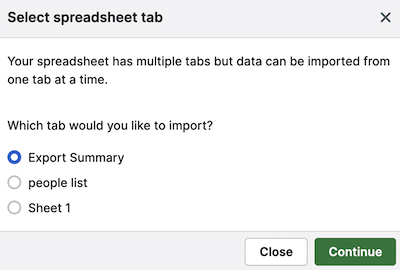
- Spreadsheet size limit – There is no maximum limit on the number of spreadsheet columns, but the maximum file size is 50MB, with a limit of 50,000 rows per spreadsheet.
Mandatory fields
When importing data to Pipedrive from a spreadsheet, include the mandatory fields for each item. Each mandatory field needs a separate column in your spreadsheet mapped to the corresponding field in Pipedrive.
Our sample spreadsheet contains a second tab called “READ ME All default Pipedrive fields,” where you‘ll find all the default data fields in Pipedrive, with the mandatory fields highlighted with a red asterisk.
To import: |
You need these mandatory fields: |
Leads |
|
Deals |
|
People |
Note: We recommend adding email and phone numbers to avoid duplicates and confusion in case of homonyms. |
Organization |
Note: We recommend adding the address to avoid duplicates and confusion. |
Products |
Note: We recommend adding unit prices for practicality |
Notes |
|
Activities |
|
You can read more about mandatory fields for importing in this article.
Custom fields
If your spreadsheet has data for leads, deals or contacts that isn’t covered by default fields, add a custom field before importing so your data has somewhere to be mapped.
For example, “job title” is not a default field in Pipedrive. To include this information in your import, create a custom person field and map the spreadsheet column to the newly created field. In this example, we recommend a text or single-option field.
You can also create custom fields during the mapping stage of your import. Learn more about custom fields in this article.
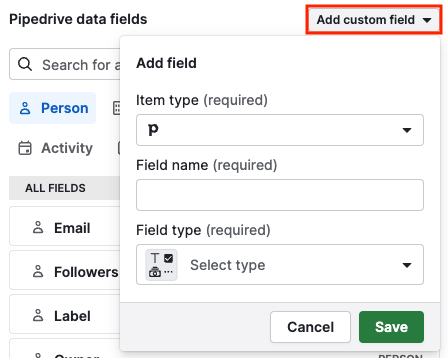
Initiating your import
Step 1: Upload your file
Go to “...” (More) > Import data > Import from spreadsheet. Click on “Get started” and select the file you intend to import. Pipedrive supports Excel (.xls and .xlsx) and .csv files.
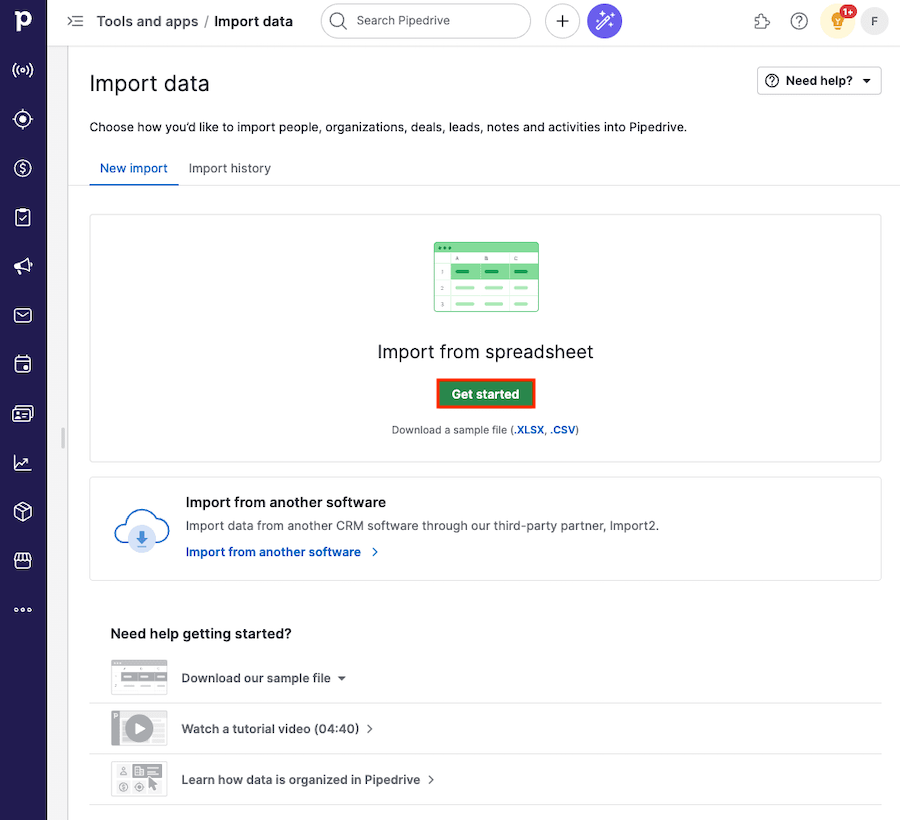
Step 2: Mapping
To import your data to Pipedrive, map each column in your spreadsheet to the relevant icon and field in the mapping step. When you hover the mouse over the data fields and click on the info icon, you can read additional details about each field to see what type of data it refers to in Pipedrive, the field type (text, number, phone, etc.), and its data import guidelines.
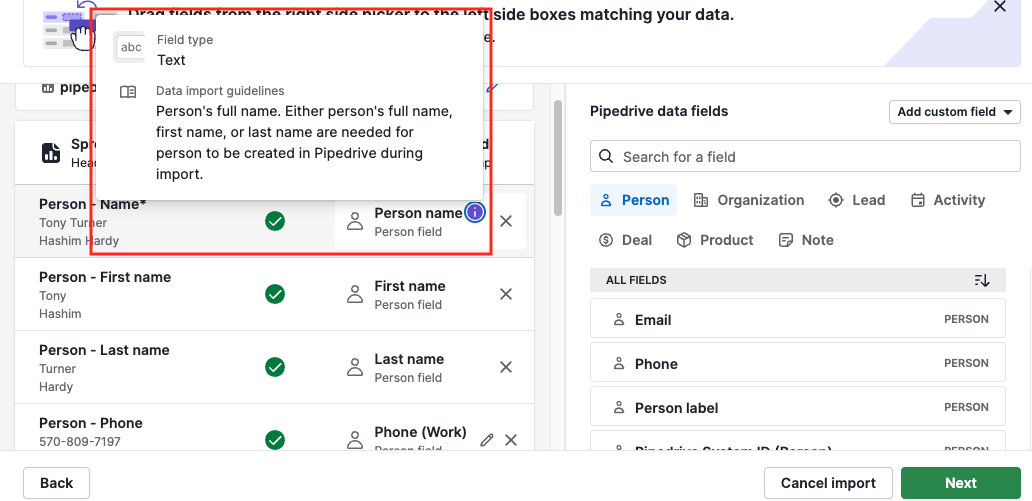
The Pipedrive data fields on the right are sorted by relevance, but you can change the sorting to alphabetical by clicking on “Sort fields”.
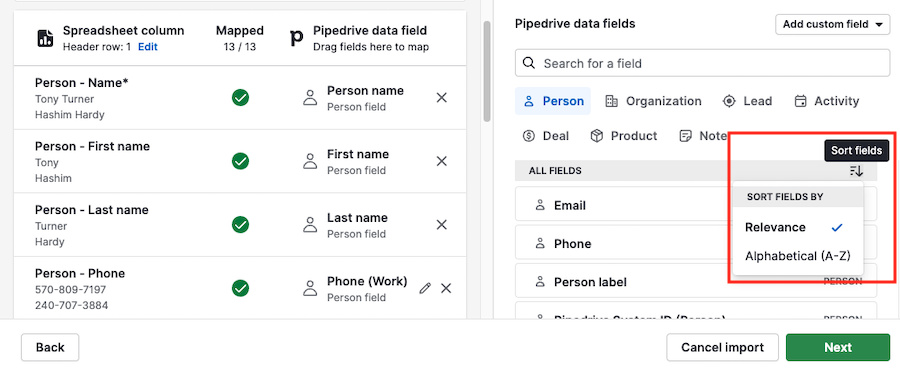
The auto-recognition feature will automatically match the column header to the fields in Pipedrive. Any unrecognized fields must be dragged from the Pipedrive fields (right) to their appropriate spreadsheet columns (left). Use the search bar to find Pipedrive field names more easily.
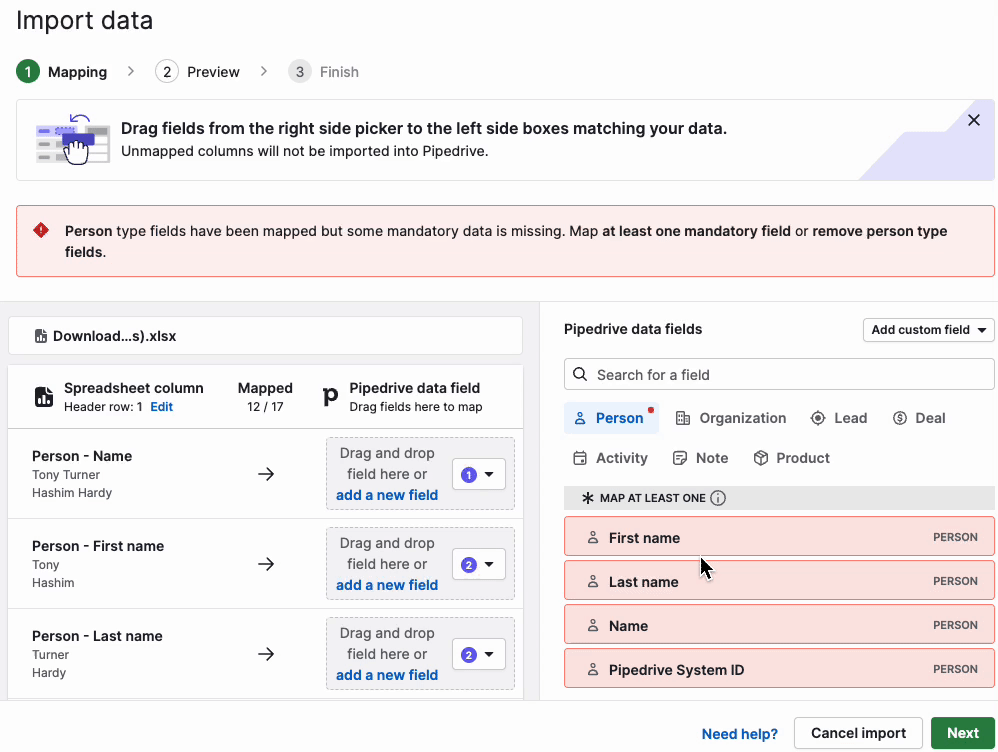
Once you’re finished mapping, click “Next.”
Step 3: Preview and finish
This page previews your data after the import. We recommend navigating through the data tabs to validate the import.
Once you’ve validated your import, click “Next.”
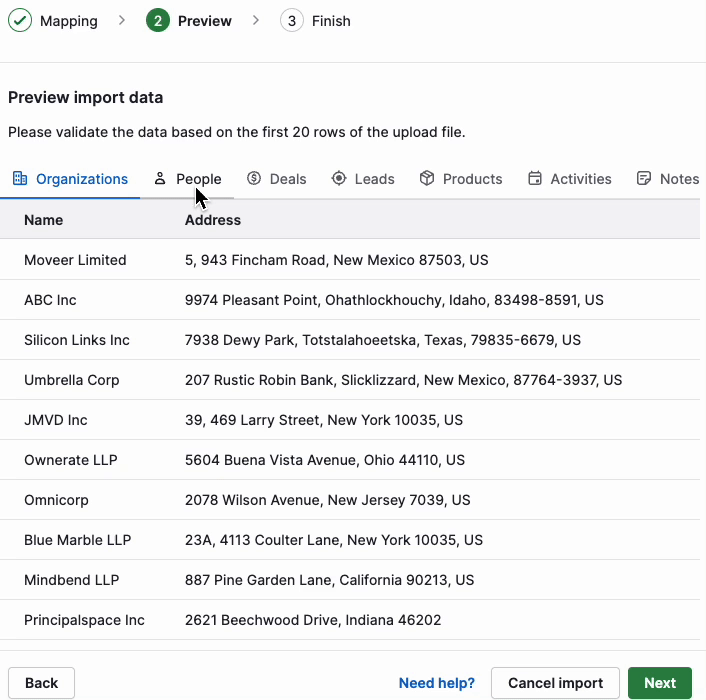
In the next window, choose what to do if duplicates are found in your spreadsheet. If Pipedrive detects a duplicate record in your spreadsheet or Pipedrive data, it will consolidate this into one entry.
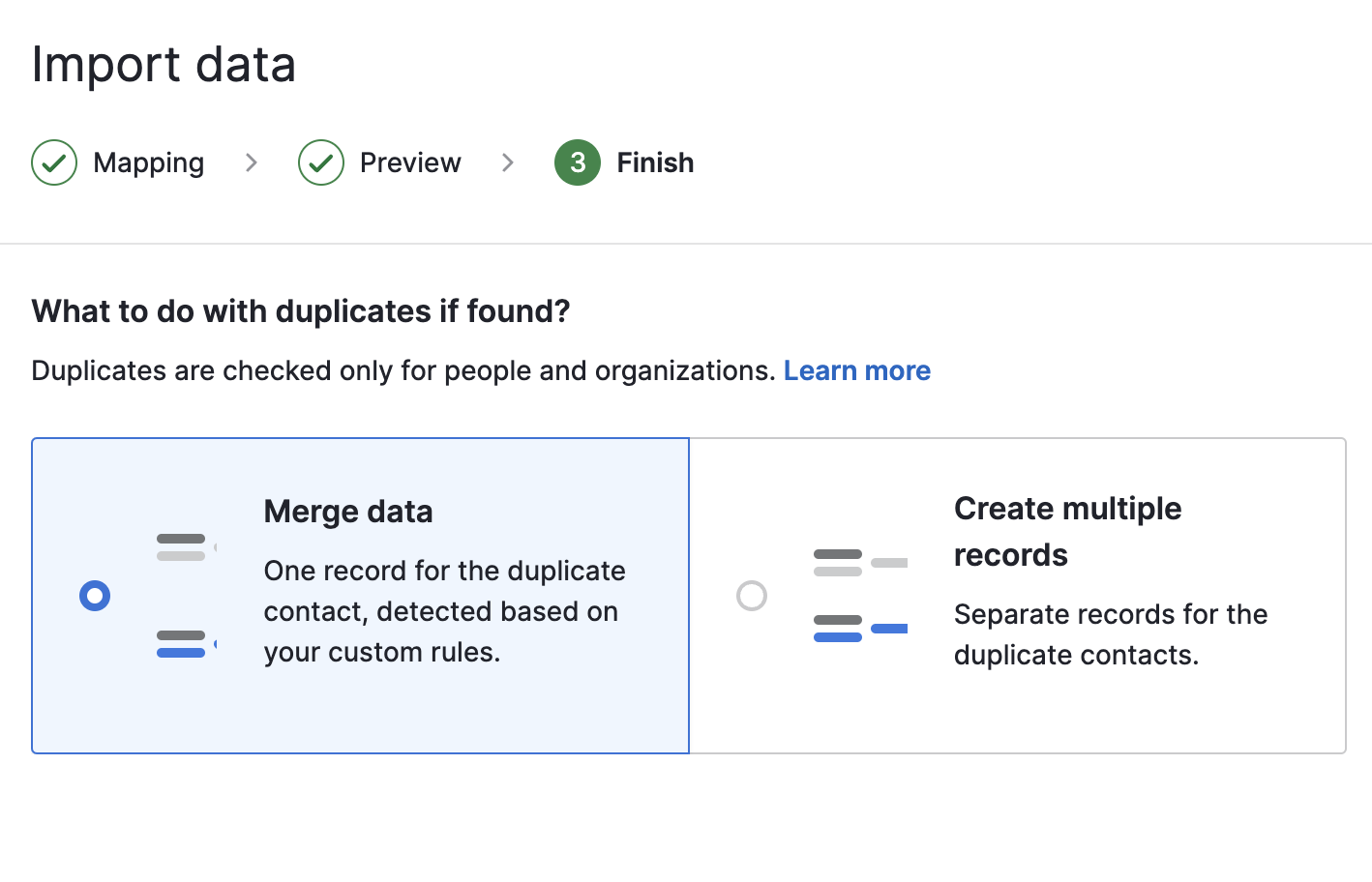
You can learn more about how Pipedrive detects duplicates during importing in this article.
When everything looks good, click “Start import”.
After your import
After your import, you’ll see a confirmation page with an overview of the imported data.
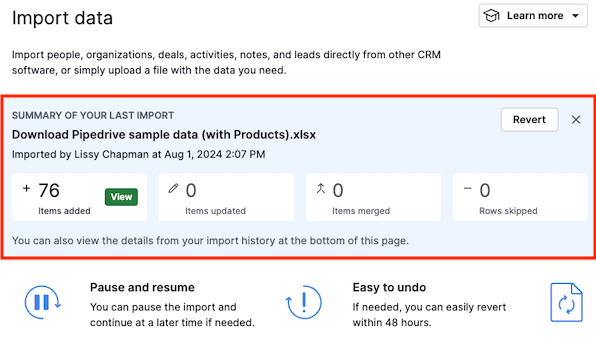
What is a “skip file”?
Any items imported incorrectly are put together in a skip file, which includes the row where the complication occurred and the reason why.
For example, if you import a list of people and don’t include a mandatory field (e.g., person name), that row of information will be skipped. Pipedrive will then take that row and organize it in a skip file.
You can download the skip file at any time to review these errors and make the needed changes directly in the spreadsheet, then import the skip File into Pipedrive to complete your import. This ensures all of your data makes it into the system.

Your skip file will look like this:

Wondering, “Why was my import data skipped?” Learn more about it in this article.
How do I revert an import?
A spreadsheet import can be reverted within 48 hours of its initial import with the revert button provided in your import history.
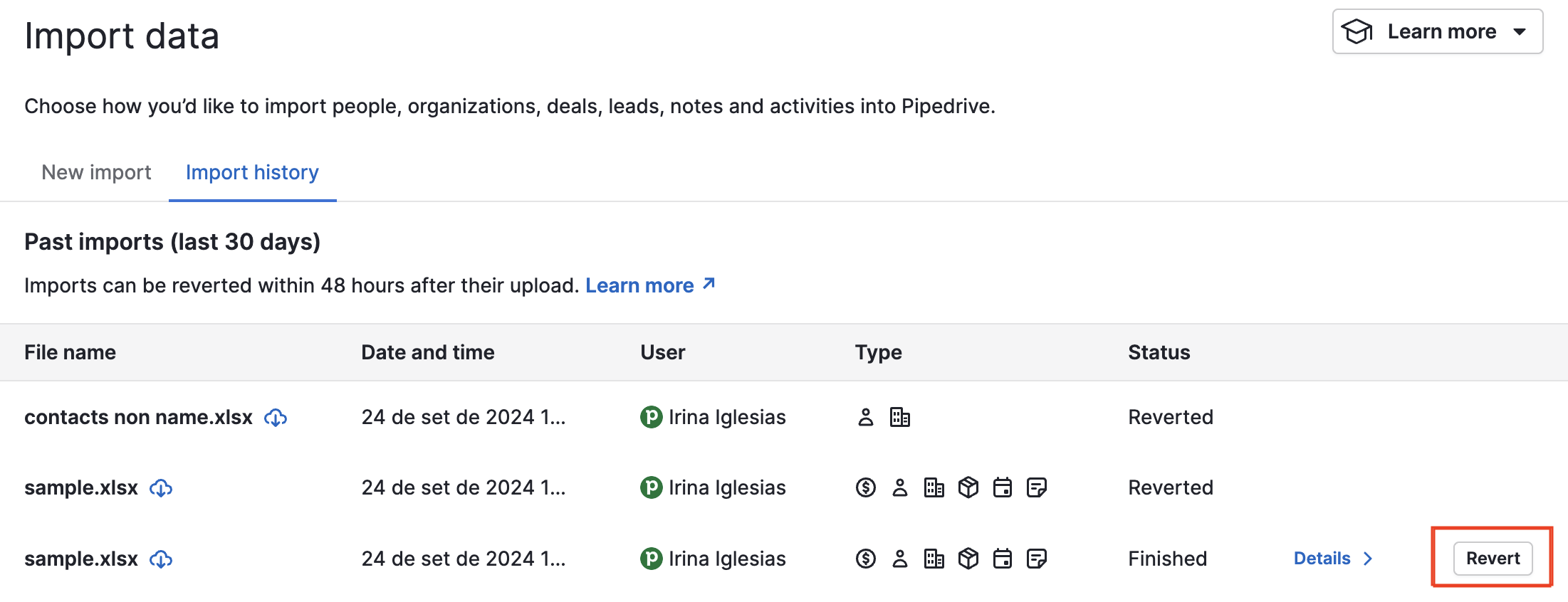
Was this article helpful?
Yes
No